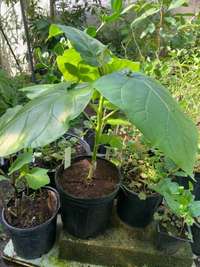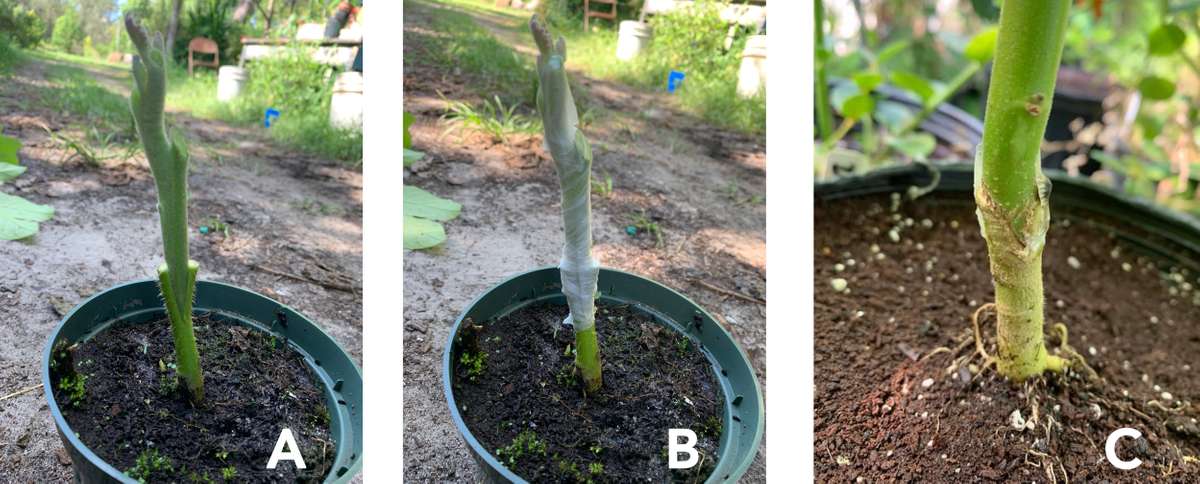The problem of nematodes
Many of the world’s most important vegetable crops originate from the Solanaceae plant family, including tomato, eggplant, and peppers. This family also includes a host of lesser-known but locally important species, such as naranjilla (Solanum quitoense), tamarillo/tree tomato (S. betaceum), and goldenberry (Physalis peruvianus). Unfortunately, many plants in this group are plagued by root-knot nematodes and other root-born diseases (such as fusarium wilt) that greatly complicate cultivation. This difficulty is especially pronounced in the tropics where harmful nematodes are prolific. My article highlights a simple, low-input strategy for working around this problem that may be relevant to smallholder farmers in the tropics and subtropics.

Figure 14. A successful tree tomato graft beginning to take off in a pot. Source: Josh Jamison
Root-knot nematodes are a group of microorganisms from the genus Meliodogyne. They infect the root systems of many crops, compromising the plants' abilities to efficiently move water and nutrients through their vascular systems. In solanaceous crops, a severe infection often results in persistent wilting despite the ample availability of water in the root zone. The nematodes ultimately undermine the entire health of the plant and lead to collapse of the crop.
Tremendous effort is expended in controlling this pest in the tropics. In the book Of Plants and People, Charles Heiser (1992) reported incredible deforestation tied to nematode infestation in naranjilla farming in Ecuador. Farmers would clear new patches of forest to farm naranjilla and experience a year or two free of nematode infestation. Eventually, nematodes would find their way in and wreak havoc, spurring farmers to clear-cut new patches of forest for their farming ventures. Other control measures include the use of hazardous and expensive agro-chemicals, crop rotation, and the breeding of crop varieties that have resistance to nematodes. For many smallholder tropical farmers, these strategies may be challenging to achieve or be undesirable for many complex reasons.
Grafting as a solution to nematodes
In agriculture, grafting is most often employed to preserve the genetics of the scion (the piece grafted on) for predictable quality, seasonality, and other traits. In the case I describe, the goal is to employ the nematode-resistant qualities of the rootstock (the plant the scion is grafted onto). By grafting a desired solanaceous crop onto appropriate rootstock, it can grow unimpeded by the aforementioned root problems (Figure 14). This results in longer-lived plants that are more productive, yielding more food and income for the farmer. In my experience, it is sometimes the difference between total crop death and success. In some countries, tomatoes [of a given variety] are regularly grafted onto other select nematode-resistant tomato varieties, usually when plants are quite small and tender.2 Here, I share about using other hardy, tropical species as rootstock for sensitive crops.
Context and initial inspiration for grafting
My experimentation with nematode-resistant rootstocks has been in the context of Central Florida, a region with sandy soil that has high populations of nematodes that harm solanaceous crops. I have used two species of hardy tropical shrub as rootstock: Solanum torvum (turkey berry) and Solanum macranthum (potato tree). Turkey berry is cultivated as a food crop in Southeast Asia and the Caribbean, and potato tree is a cultivated ornamental. Both species grow vigorously in our soils, seemingly unaffected by harmful nematodes. [CAUTION: Be aware of toxins in solanaceous crops (discussed later in this document). Additionally, S. torvum can spread rapidly as a weed; click here for a CABI datasheet with more information.] The main scion species I have experimented with are eggplant (Solanum melongena), naranjilla (Solanum quitoense), and tamarillo (Solanum betaceum).
My interest in grafting solanaceous crops began with tamarillo, a crop that is widely believed to be impossible to grow in Florida. The general view is that the climate here is too hot, and that this plant requires the cooler, more moderate temperatures of its native habitat in the Andes. That was also my perception as I briefly experimented with the plant years ago, writing it off as something unable to grow in Florida.
Then, while visiting a farm in Florida last year, I noticed I was standing under the canopy of a fruiting tamarillo! Upon inspection and inquiry, I learned that the plant was grafted to a sucker at the base of an ornamental potato tree, S. macranthum. Also grafted to the potato tree (and fruiting), was cocona, S. sessiflorum. Cocona is another species with which I had briefly experimented in the past and gave up on after lackluster results. I had an epiphany! Perhaps climate was not the reason that tamarillo and cocona failed in gardens; what if the problem was with the root systems instead? I promptly gathered seed of the potato tree and made plans to use it as a rootstock.
Grafting method used
The technique I have employed is cleft grafting, using terminal growth as scion (Figure 15). I plant the rootstock and the desired crop in the nursery on the same day, so that I can work with plants of roughly the same size. For grafting, I prefer a stem diameter around 0.5 to 1.0 cm. I cut the top of the scion seedling, remove the top of the rootstock seedling, and then graft the scion piece (top of the scion seedling) of my desired crop onto the remaining (bottom) portion of the rootstock seedling. Then I remove all leaves from the scion, taking care not to damage the emerging terminal bud. I wrap the graft union and scion tissue with parafilm to exclude water from the graft union and keep the tissue from desiccating. The very tip of the scion can be left unwrapped, which allows new growth to easily emerge. Another option to prevent desiccation, besides wrapping the graft union with parafilm, is to bag the plants with clear plastic. Bagging the grafts can help increase humidity, but be sure you do not leave them in the sun, or they will cook. Keep freshly grafted plants in the shade under highly humid conditions.
Slowly acclimate grafts to sunlight over a period of a week to ten days. For bagged grafts, this process starts with removal or tearing of the bag to expose the graft to ambient conditions. I tend to tear a hole in the bag and, over a few days, make the tear larger. This is why I prefer parafilm with the terminal bud uncovered, as it eliminates the step of removing the bag over each graft. I move the plants a little further out of the shade each day during morning watering.

Figure 2. A cleft graft before (A) and after (B) wrapping and a healed, successful graft union (C). Source: Josh Jamison
Grafts of herbaceous plants heal and grow much more rapidly than grafted woody plants; an abundance of cambial tissue in these soft-tissued plants means that high precision with cuts is not as important as it is with woody species. If the above-mentioned basic procedures are followed, graft success rate is very high.
Results of personal experimentation
Grafting tamarillo and naranjilla to S. macranthum proved to be easy. After a little less than a year of experimentation, I have thriving tamarillo plants that endure the hottest part of the year without much issue. Some of those plants are now taller than I am and are beginning to flower. I have not yet successfully brought tamarillo to fruition, but I count the experience as a major success in demonstrating that this plant and others can greatly benefit from being grafted to nematode-resistant rootstocks. Naranjilla is typically badly affected by nematodes in Central Florida, but my grafted naranjilla plants are thriving and soon will have fruit.
I have also grafted eggplant to S. torvum, and the rootstock seems to give the plants more general hardiness and longevity.3 A friend grafted tomatoes to S. torvum and reported above-average vigor, resistance to disease, and good overall crop performance. In Kenya, where tamarillo is farmed on a broad scale and is widely grafted onto a locally available rootstock (S. mauritanium), the interspecific graft is said to increase general crop success and to confer drought tolerance to tamarillo. Increased nematode resistance could help explain the reported resilience of grafted plants.
The Solanum genus seems to have very broad graft compatibility. Every graft combination I have tried thus far (including 7 or more species) has succeeded with no apparent problem. That said, some combinations seem to show more vigor than others. Tamarillo and naranjilla tend to grow better on S. macranthum, while eggplant seems to prefer S. torvum.
A caution about toxins
There is an important question to consider regarding solanaceous grafting: can toxins migrate from the rootstock of a plant up into the scion tissue, generating toxic fruit? I posed this question to the Florida farmer who grew the tamarillo that I had been so surprised to see fruiting (given that S. macranthum is a toxic plant). He dismissed my concern and told me that he had eaten from these graft combinations for years with no problems. However, through word of mouth I learned that a well-known fruit specialist in South Florida insists that grafting to Datura species (a group of highly toxic plants) creates toxic fruit.4 I think caution is prudent. It is wisest to proceed using known edible species or ones that have already been recorded for this use.
Farmer application
Each farmer will need to determine if the increase in plant health and yield outweighs the cost in time and energy spent on grafting. Local economies and specific growing conditions will dictate the outcome of this calculation, but it may depend largely on the density at which a crop is planted. For example, tamarillo is often planted at 1/10 or less the density at which tomatoes are planted, so grafting tamarillos can be more cost effective because the grafting will take much less time. Tamarillos also live much longer, so grafting needs to happen less often. Economic considerations aside, grafting solanaceous crops shows tremendous promise as one way to adapt these crops to less-than-ideal soil conditions. I think it merits attention in the tropics as a practical way to allow more farmers to grow high-value vegetables. Where Solanum crops are limited by root problems, grafting is worth a try. While trying various rootstock/scion combinations, look for ways to graft them using locally available materials.
References
Bletsos, F., C. Thanassoulopoulos, and D. Roupakias. 2003. Effect of grafting on growth yield, and verticillium wilt of eggplant. HortScience 38(2):183-186.
Heiser, C.B. 1992. Of Plants and People. University of Oklahoma Press.
Oshiro, N., K. Kuniyoshi, A. Nakamura, Y. Araki, K. Tamanaha, and Y. Inafuku. 2008. A case of food poisoning due to ingestion of eggplant, Solanum melongena, grafted on devil’s trumpet, Datura metel [in Japanese]. Shokuhin Eiseigaku Zasshi 49:376-379.
Petran, A. and E. Hoover. 2014. Solanum torvum as a compatible rootstock in interspecific tomato grafting. Journal of Horticulture 1:103.
Further Reading
Hu, B., S. Short, M. Soltan, and M.D. Kleinhenz. (year not given). Grafting Guide 3rd Edition: A Pictorial Guide to the Cleft and Splice Graft Methods for Tomato and Pepper. Bulletin 950. Internet website accessed 15 October 2020: http://www.walterreeves.com/wp-content/uploads/2010/11/tomato-grafting-guide.compressed.pdf [See pages 55 to 65 for detailed explanation and photos of the cleft grafting technique on tomato seedlings.]
Documented examples of S. macranthum as rootstock:
- Ledin, B.R. 1952. The naranjilla (Solanum quitoense LAM.). Florida Agricultural Experiment Station Journal Series, No. 106:187-190. [This article records Dr. Milton Cobin’s success in grafting naranjilla on S. macranthum.]
- Whitman, W. 1958. Rare Fruit Council activities 1957-58. Florida State Horticultural Society Proceedings 71:278-287. [Grafts of naranjilla on S. macranthum were made available for distribution as a Rare Fruit Council activity.]
- Hodge, D. 1995. The archives of The Rare Fruit Council of Australia. Internet website accessed 15 October 2020: https://rfcarchives.org.au/Next/CaringForTrees/Rootstocks9-95.htm. [Mention is made of tamarillo grafted on S. macranthum.]
Cite as:
Jamison, J. 2020. Grafting Tamarillo and Other Solanaceous Crops for Nematode Resistance. ECHO Development Notes no. 149